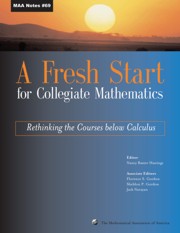Book contents
- Frontmatter
- Preface
- Contents
- Introduction
- Background
- Theme 1 New Visions for Introductory Collegiate Mathematics
- 7 Refocusing Precalculus: Challenges and Questions
- 8 Preparing Students for Calculus in the Twenty-First Century
- 9 Preparing for Calculus and Preparing for Life
- 10 College Algebra: A Course in Crisis
- 11 Changes in College Algebra
- 12 One Approach to Quantitative Literacy: Understanding our Quantitative World
- Theme 2 The Transition from High School to College
- Theme 3 The Needs of Other Disciplines
- Theme 4 Student Learning and Research
- Theme 5 Implementation
- Theme 6 Influencing the Mathematics Community
- Ideas and Projects that Work: Part 1
- Ideas and Projects that Work: Part 2
12 - One Approach to Quantitative Literacy: Understanding our Quantitative World
from Theme 1 - New Visions for Introductory Collegiate Mathematics
- Frontmatter
- Preface
- Contents
- Introduction
- Background
- Theme 1 New Visions for Introductory Collegiate Mathematics
- 7 Refocusing Precalculus: Challenges and Questions
- 8 Preparing Students for Calculus in the Twenty-First Century
- 9 Preparing for Calculus and Preparing for Life
- 10 College Algebra: A Course in Crisis
- 11 Changes in College Algebra
- 12 One Approach to Quantitative Literacy: Understanding our Quantitative World
- Theme 2 The Transition from High School to College
- Theme 3 The Needs of Other Disciplines
- Theme 4 Student Learning and Research
- Theme 5 Implementation
- Theme 6 Influencing the Mathematics Community
- Ideas and Projects that Work: Part 1
- Ideas and Projects that Work: Part 2
Summary
Overview and philosophy of the course
The calculus reform movement sparked numerous conversations about pedagogy and curricula on campuses throughout the country. However, it is only recently that the national conversation has spread to courses below calculus. These include courses that potentially lead to calculus, such as college algebra and precalculus, as well as courses that students take primarily to fulfill general education requirements. Part of the confusion is that many courses serve one purpose in theory yet serve another purpose in practice. For example, many topics in college algebra and precalculus textbooks are included because they are necessary background for standard topics in differential or integral calculus. Yet the percentage of students enrolled in college algebra or precalculus courses who eventually take two semesters of calculus is quite small. So, in practice, college algebra and precalculus are primarily serving as general education courses or as preparation for courses outside of mathematics. However, a course designed for one purpose (preparation for calculus) is not necessarily well designed for another purpose (general education credit or preparation for courses outside of mathematics). One response to this situation is the creation of additional mathematics courses and implementation of effective advising procedures so that students take the mathematics course that is most appropriate for their needs.
The primary need for many students is to become quantitative literate citizens who are capable of interpreting and using information presented quantitatively.
- Type
- Chapter
- Information
- A Fresh Start for Collegiate MathematicsRethinking the Courses below Calculus, pp. 101 - 108Publisher: Mathematical Association of AmericaPrint publication year: 2006
- 1
- Cited by

